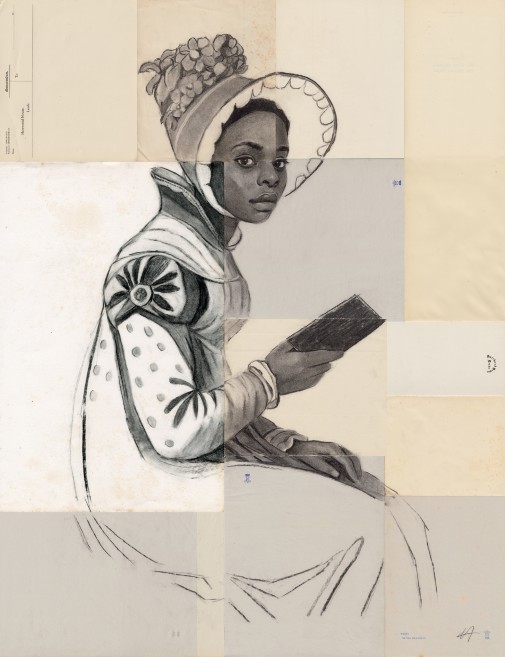Miss Lambe, the only character explicitly of African heritage in a Jane Austen novel, has been brought to life by a contemporary visual artist for a special exhibition celebrating the 250th anniversary of Jane Austen's birth.
 Miss Lambe, 2025, Charcoal on found paper 80cm x 65cm, Lela Harris and Harewood House Trust
Miss Lambe, 2025, Charcoal on found paper 80cm x 65cm, Lela Harris and Harewood House Trust
A wealthy heiress, described as 'young', 'sweet' and 'thin', Miss Lambe features in Jane Austen's final novel, Sanditon. Austen died before the novel was completed, which means that for centuries readers have been left guessing as to what Miss Lambe's journey would have been.
As part of Harewood House's 'Austen and Turner: A Country House Encounter' exhibition, whose curatorial team includes University of York experts, Professor Jennie Batchelor, Dr Marjorie Coughlan, Dr Richard Johns and Professor Chloe Wigston Smith, Miss Lambe has been created by contemporary visual artist and exhibition Artist in Residence, Lela Harris.
The portrait's surface has been pieced together from 20th century stationery from Harewood House, an eighteenth-century property and estate built on the profits of the transatlantic trade in enslaved people. In her preparatory work for this portrait, Harris used the technique of collage to build a picture of Miss Lambe beyond Austen's unfinished manuscript, imagining the character within the context of Harewood and its complex histories and collections.
Lady's Magazine
The portrait is partially inspired by research from Professor Jennie Batchelor, from the University of York's Department of English and Related Literature, on the fashions depicted in the Lady's Magazine, a popular publication that Jane Austen is known to have read and likely took embroidery patterns from.
Lady's Magazine was a monthly women's magazine, published between 1770 and 1832 and contained fiction, poetry, essays, news, fashion, sewing patterns, and music. Professor Batchelor's work focused on the influence of the magazine, which included evidence of Austen's interest in the publication
Professor Batchelor said: "Austen has pulled many aspects of the magazine into her novels, which included character names and even the title of one her most popular works Sense and Sensibility.
"Lela and I discussed a fashion plate, featured in the magazine, in October 1819, called 'Sea-side Walking Dress', which is particularly striking in design. Although the image was printed a couple of years after Austen's death in 1817, it was typical of the fashionable styles of the late 1810s.
"It is remarkable how Lela has taken this illustration and figure and reimagined it to bring to life one of the most intriguing characters that Austen created."
Unfinished
Harris' portrait of Miss Lambe remains unfinished, echoing both the incomplete nature of Sanditon as well as highlighting the historic erasure of women of colour from archival spaces. Detail is concentrated in Miss Lambe's face and hands, giving Austen's character life, whilst incomplete areas of clothing reflect the sitter's unfinished narrative.
Harris's portrait sits alongside new work by the award-winning poet and performer, Dr Rommi Smith, Harewood's Writer in Residence for the duration of the exhibition. Through experimentation with poetic form and composition, as well as her research into the life and work of Austen and Turner, Smith has begun a series of new poems responding to the historic material and themes of the show.
The first two poems in the series are specially printed for display in collaboration with Thin Ice Press, at the University of York.
Complex history
Lela Harris said: "With this portrait I've really indulged my inner Austen fan girl as well as being very inspired by Jennie Batchelor's collection of 18th-century fashion plates from the Lady's Magazine.
"I greatly admire Austen for the way she so casually introduces Miss Lambe into Sandition. There seems to be no fanfare or overemphasis on her ethnicity, especially with regards to her wealth, which is really refreshing, so I've tried to integrate this feeling into her portrait.
"Being able to use 20th-century papers from Harewood's stationery cupboard was a real joy. I think the writing papers help to anchor the drawing in Harewood's complex colonial history and I very much enjoyed the challenge of working across slightly different surfaces."
'Stunning'
Professor Batchelor, added: "We have waited centuries for an artist to bring Miss Lambe to life and I can't think of a better tribute than Lela's stunning, richly textured and tender portrait of the only figure explicitly of African descent in a Jane Austen novel.
"It is fitting that Miss Lambe sits at the seaside resort of 'Sanditon' with a book in her hand and I can't help but wonder what she is reading? It feels even more fitting that she looks directly at the viewer, inviting us to see her as if for the first time."
'Austen and Turner: A Country House Encounter'






